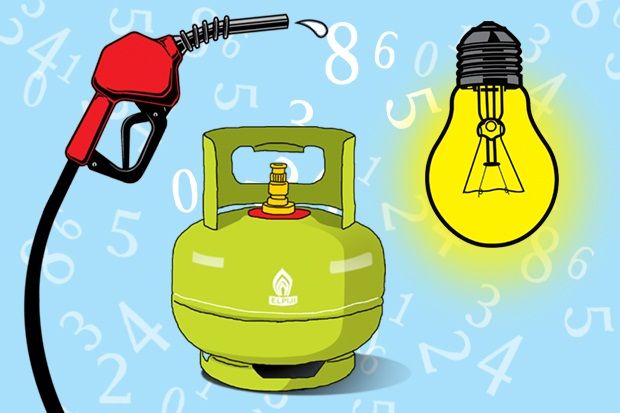Increasing Energy Subsidy Budget Allocation to Maintain People’s Purchasing Power
By : Ricky Partomo )*
The government will increase the energy subsidy budget allocation for the people in 2022 to Rp. 134 trillion . The addition of the subsidy budget allocation is expected to maintain people’s purchasing power.
Minister of Energy and Mineral Resources (Minreal Energy and Resources) Arifin Tasrif said the realization of energy subsidies, including for electricity, fuel oil (BBM) and LPG in 2021, reached Rp. 131.5 trillion.
This realization increased when compared to 2020 which was only Rp. 110.5 trillion. The increase in subsidies was carried out to maintain people’s purchasing power during the process of economic recovery from the pressure of COVID-19. Arifin detailed that the largest realization of energy subsidies occurred in the fuel and LPG subsidy posts. Realization of the subsidy reached Rp 83.7 trillion. Meanwhile, the electricity subsidy is Rp. 47.8 trillion.
On the occasion of the 2021 ESDM Performance press conference, Arifin said energy subsidies were maintained to maintain people’s purchasing power, especially in the context of economic recovery.
He stated that the energy subsidy allocation for next year will increase again to Rp. 134 trillion. Rp. 77.5 trillion of which is allocated for subsidies for fuel and LPG and Rp 56.5 trillion for electricity.
On the same occasion, Arifin also conveyed that the realization of non-tax state revenue (PNBP) of ESDM last year managed to penetrate Rp. 189, trillion. It reached 156 percent of the target. The largest energy PNBP was contributed by oil and gas (oil and gas) worth Rp. 103.2 trillion, followed by mineral and coal of Rp. 75.5 trillion and other components.
Arifin said that the realization of investment in the ESDM sector also exceeded the target or worth US$28.2 billion in 2021. The most posts were contributed by oil and gas, electricity, mineral and coal and EBT, respectively.
Energy subsidies are required as well as a socio-economic obligation of the Government. Economic growth can be guaranteed if subsidies are right on target, otherwise if they are not well targeted then subsidies become ineffective and cannot be reached by the community.
Subsidies for Fuel Oil (BBM) and Liquified Petroleum Gas (LPG) are the joint task of the Government and the House of Representatives to change the subsidy scheme in the future so that subsidy recipients are more targeted.
Based on BPS (Central Statistics Agency) data, public access to electricity is still low, especially in disadvantaged, frontier and outermost (3T) areas, therefore subsidies must be fair so as to increase people’s purchasing power.
The objective of the subsidy policy is the social protection of the community. In order for subsidies to be more targeted, the subsidy scheme needs to be changed from commodity-based to beneficiary-based. The DPR and the Government need to sit down together to discuss the subsidy mechanism.
Previously, DPR Banggar Member Bobby Adhityo Rizaldi explained that his party had set a budget for the 2022 energy subsidy management program at Rp. 134 trillion. The amount is in accordance with the government’s proposal listed in the 2022 APBN draft.
Fuel and LPG subsidies are components of the energy subsidy management program, in addition to electricity subsidies. The DPR has determined that the allocation of subsidies for BBM and 3 kilograms of LPG is Rp. 77.5 trillion.
According to Bobby, Banggar has agreed that the policy direction in 2022 is to continue providing fixed subsidies for diesel fuel. Then, there is a subsidy from the difference in the price of kerosene and 3-kilogram LPG cylinders.
Previously, the Minister of Finance (Menkeu) Sri Mulyani would direct the energy subsidy policy in 2022 to be more targeted through the implementation of a policy of transforming commodity-based subsidies into beneficiary-based subsidies. He said the policy would be carried out gradually and carefully taking into account the economic and social conditions of the community.
Furthermore, the government will also review whether the diesel subsidy is also directed to a people-based subsidy. Therefore, an evaluation of the implementation of the diesel subsidy policy will be carried out, so that it is in line with the targeted subsidy policy.
Sri Mulyani said the government would make efforts to improve the Integrated Social Welfare Data (DTKS) by conducting regular verification and validation and encouraging the development of an integrated system with data on target recipients of subsidies.
The people’s purchasing power is one of the indicators showing the development of the nation’s economy, purchasing power is also one of the government’s concerns to take appropriate and measurable fiscal policies.
)* The author is a contributor to the Press Circle and Cikini Students
